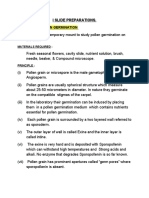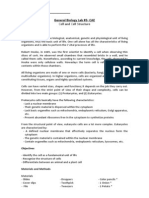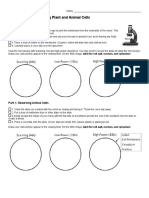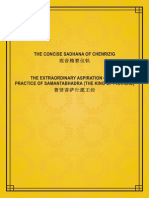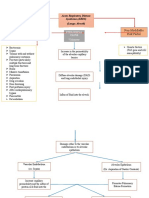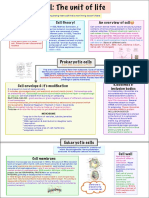Transport of Materials in Flowering Plants
Transport of Materials in Flowering Plants
Uploaded by
Lim Kew ChongCopyright:
Available Formats
Transport of Materials in Flowering Plants
Transport of Materials in Flowering Plants
Uploaded by
Lim Kew ChongOriginal Description:
Copyright
Available Formats
Share this document
Did you find this document useful?
Is this content inappropriate?
Copyright:
Available Formats
Transport of Materials in Flowering Plants
Transport of Materials in Flowering Plants
Uploaded by
Lim Kew ChongCopyright:
Available Formats
Name: Class:
TransportofMaterialsinFloweringPlants
Investigation 8.1 To examinetheinternalstructureofa
dicotyledonousstem, rootandleaf
t.
',-'
0:
.. :....:.;,.
. a di<;otyledonousroot .
.
a ha'tld
Procedure
1. Examine the transverse section of
the dicotyledonous stem using a
hand lens or a stereomicroscope.
Make a drawing to show the
distribution of the vascular
bundles. (Do not draw
individual cells.)
Label the following: epidermis,
cortex, vascular bundles and
pith.
T.S. of a stem
2. Examine the transverse section of
the stem under the low power
microscope.
Draw one vascular bundle.
(Do not draw any cells.)
Label the following: phloem,
cambium and xylem.
A vascular bundle
3. (a) Whatis thefunctionofthephloem?
(b) Whatarethefunctionsofthexylem?
4. Examinethetransversesectionofthedicotyledonousrootunderthelowpower
microscope.Makeadrawingoftheroottoshowthedistributionofthexylemand
phloemwithintheoutlinediagramshownbelow.Alsodrawandlabelthe
following: piliferouslayer,roothairsandcortex. (Donotdrawanycells.)
o
T.S. of dicotyledonous root
5. Examinethetransversesectionoftheleafprovidedunderalowpowermicroscope.
Drawtheoutlineofthemidribandpartofthelamina.Withinthisoutline,drawthe
distributionofthexylemandphloeminthemidribandinonebranchvein.Also
drawandlabel:theupperandlowerepidermis,astomawithguardcells,cuticle,
palisaJeLissue,spongymesophyll..(Donotdrawanycells.)
T.S. of leaf
Name: Class:
Investigation 8.2 To show the path of water through a plant
Procedure
1. TakeayoungBalsamplantandwashitsrootwithwatertoremovethesoilparticles.
2. Allowtheplanttostandwithitsrootsimmersedindiluteeosin(red)solutionfora
fewhours.
3. Afterafewhouryoucanseethattheredeosinsolutionhasrisenuptheplant,right
uptotheveinsintheleaves.Cutthintransversesectionsofthestemandtheportion
oftherootnotimmersedintheredsolution.
4. Placeonesectionofthestemandanotheroftherootonaglassslide.Examinethe
sectionsunderthelowpowermicroscope.
S. Whichtissuehasbeenstainedred?
6. Withintheoutlinediagramsgivenbelow,drawandlabelthedistributionofthe
tissuethathasbeenstainedred.
T.S. of a root
T.S. of a stem
7. Whatcanyouconcludefromyourinvestigation?
8. Below is an outline diagram of a leaf. Shade and label the tissue through which
water enters the leaf.
vein
J----- midrib
T.S. of a leaf
Name: Class:
Investigation B.3 The "Ringing" experiment
Procedure
1. Cutoffacompleteringofbarkfromthemainstemofawoodytwiguntilthexylem
(orwood)isexposed(twigA shownbelow).Placethetwiginwaterwiththering
immersed.
2. Comparethiswithanothertwigthathasaringcutabovethewaterlevel(twigC).
3. SetupacontrolusinganunringedtwigB.
4. Placetheapparatusnearthewindowwherethetwigsreceivedsufficientsunlight.
regionwith
barkremoved
f---i-+--+- unringedstem
water
Fig. S.l
5. Observethetwigsdaily. Notewhereadventitiousrootsorswellingsappear.Make
drawingsofyourobservations.
Questions
1. What does this experiment tell you about the function of the phloem?
2. Suggest an explanation for your observation.
Name: Class:
Investigation 8.4 To demonstraterootpressure
1?P.atus and Materials
a
atubbertubing
aretort.sta.nd
., .
Procedure
1. Cutofftheshootofanactivelygrowingpottedplant,leavingaportionofthestem
about5emabovethesoiL
2. Fitaglasstubingabout20emlongfirmlytothecutendofthestembymeansofa
rubbertubingasshownbelow.
glass tubing----1
r--- retortstand
water------+1
stem--...,------1.'
pot---
Fig. 8.2To demonstrate root pressure
3. Partlyfill theglasstubingwithwaterandsupportitwitharetortstand.Markthe
levelofthewaterintheglasstubing.
4. Waterthesoilwell.Afterafewhoursnotethelevelofthewaterinthetubing.
5. Recordyourobservation.
6. Give an explanation for your observation.
Name: Class:
Investigation 8.5 To show transpiration in leaves and stems
(Teachers demonstrationj
andMaterials
apottedplant
apotofsoil
2belljars
2polythenebags!!..
. anhydrouscoppersul.fha%
Procedure
1. Takeapottedplantandwrapapolythenebagroundthepotandthestemofthe
plant.
2. PlacethepotonaglassplateandcoveritwithadrybelljarasshowninFig. 8.3.
3. Setupacontrolusingsimilarapparatusbutwithouttheplant.
4. Placethetwojarssidebysideinsunlightforonehour.
Control
\--- belljar----I
1---'----\-- pottedplant
I--+--polythenebag---I-----i
ofsoil
glassplate
Fig. 8.3
5. Whatdoyouobserveafter1hourin
(a) thejarwiththeplant?
(b) thecontrol?
6. Testanyliquidontheinsideofthebelljarwithanhydrouscoppersulphate.What
doyouobserve?
Whatistheliquid?
Theliquidis ____________________________
7. Whatisthereasonfor coveringthepotwiththepolythenebag?
8. Whatconclusioncanyoudrawfromyourobservations?
Name: Class:
Investigation 8.6 To compare transpiration in leaves and stems
(Teachers demonstrationsJ
andMaterials
.
,l. .2leafytwigsof aboutthesameslze
water
2beakers
oil
2belljars vaseline
Procedure
1. Taketwoleafytwigsofaboutthesamesizefromthesameplant.Cuttheendofeach
twigunderwater.Thispreventsairfromenteringthexylemvesselswhichwould
interferewiththeabsorptionofwaterbythetwig.
2. Placeeachtwiginabeakerofwater.Addalittleoilontothewater.
3. Cutoffalltheleavesfromonetwig.Applyvaselineonthecutendsofthepetioles
(leafstalks)topreventwaterlossthroughthecutends.
4. Applyvaselineonlyonthestemsoftheothertwig(leafytwig).
5. CovereachbeakerwithabelljarasshowninFig. 8.4. Placetheapparatusin
sunlight.
leafless twigwith
cutendsofpetiole
vaselined
H_+--_1eafytwigwith
stemvaselined
-+---+----water---t---+-
Fig. 8.4
6. Whatdoyouobserveafterabout2hours?
Injarwithleafytwig:
Injarwithleaflesstwig:
7. Give an explanation for your observation
Name: Class:
Investigation 8.7 To comparetherateoftranspiration throughthe
upperandlowersurfaces ofa leafusing cobalt
chloridepapers
Procedure
Thisexperimentrequiresaplantwithstomatamainlyonthelowersurfaceoftheleaves.
1. Explainhowyoucanfindoutwhetherstomataarefoundmainlyinthelower
epidermisofaleaf.
2. Usingapairofdryforcepsplaceapieceofdrycobaltchloridepaperoneachoftwo
glassslides.
3. Sandwichanintactleaf(i.e. aleafstillattachedtotheplant)betweenthetwoglass
slidesasshowninFig. 8.5. Holdtheglassslidesinpositionusingtworubberbands.
f
I .
'I'
\.
.\
\
II
glassslides
robbe, vi"" "-",,,kngth at ,lid"
Fig. 8.5
4. Observethecolourchangeinthecobaltchloridepapers.Whichpaperturnspink
faster?
5. Why are forceps used instead of your fingers to pick up the cobalt chloride papers?
6. What can you conclude from your investigation?
Name: Class:
Investigation 8.8 To find out whether transpiration occurs mainly
through the stomata
andMaterials
, .. ....
aplantwithstomatafoulldmainly It . tiu'ea{'f$)' '0
Ollthelowersurface,e.g.broad..
vaseUne
dkotyledol\ousleaves
<l scalpt;l
."iY'
aweighfugmachine
Procedure
1. Cutoffthreeleavesofaboutthesamesizeandsurfacearea.Coatthepetioleswith
vaselinetopreventevaporationofwaterfromthepetioles
2. Tie athreadtotheendofeachpetiolesothattheleafcanbehunguptodry. Note
downtheconditionofeachleaf,i.e. turgidorflaccid,witheredornot.
3. Treatthethreeleavesasfollows:
LeafA: Covertheuppersurfacewithathinlayerofvaseline.
LeafB: Coverthelowersurfacewithvaseline.
LeafC: Coverbothsurfaceswithvaseline.
4. Weigheachleafandrecordyourresultsinthetablebelow.
5. Hangupthethreeleaveswheretheycanreceivesunlight.
LeafA LeafB LeafC
uppersurfacecovered lowersurfacecovered bothsurfacecovered
Fig. 8.6
6. Afterafewhoursobservetheconditionoftheleaves.Recordyourobservationsin
thetable.
7. Weightheleavesagain.Calculatethepercentagemasslossineachleaf.
LeafA LeafB LeafC
Conditionofleaf
atbeginning
Conditionofleaf
atendofexperiment
I
LeafA LeafB LeafC
Originalmass(g)
Finalmass(g)
Lossinmass(g)
% lossinmass
8. Nametheprocesswhichismainlyresponsibleforthelossofmassintheleaves.
9. Whichleafhaslostthemostmass?
Why?
10. Giveanexplanationforyourobservationsintheotherleaves.
Name: Class:
Investigation 8.9 To measuretherateoftranspiration ofa potted
plantunderlaboratoryconditions
(Teachers demonstration)
Procedure
1. Takeawell-wateredpottedplantandwrapapolythenebagtightlyroundthepot
andthestemoftheplant.
2. Weightheplant.Placeitnearthewindowinthelaboratory.
3. Afterafewhours,e.g.3hours,weightheplantagain.Recordyourresultbelow.
(Thelossinmassismainlyduetothelossofwatervapourduringtranspiration.)
4. Calculatetherateoftranspirationunderlaboratoryconditions.
Massofpottedplant
= g
Massofpottedplantafter3hours = g
Lossinmass
= g
=lossinmass g/h
Rateoftranspirationoftheplant
timetaken
g/h
Name: Class:
Investigation 8.10 To measure the rate of transpiration using a
potometer (Teachers demonstrationJ
;;a.leafy o o ~
,afilterflasl<
arubberbung
arubbertubing
NOTE: Apotometerisusedtomeasuretherateofabsorptionofwaterbytheplant,and
nottherateoftranspiration.Inthisexperimentweshallassumethatinsteadystate,the
rateofabsorptionofwaterisproportionaltotherateoftranspiration.
retortstand
syringecontaining
airbackto right-nand
endofcapillarytube
I
air
B
meniscus
Fig. S.S A potometer
Procedure
1. Chooseasuitableleafyplant.Cutoffashootandimmediatelyimmersethecutend
inwater.Bringtheshootbacktothelaboratory.Cuttheshootagainunderwater,a
shortdistanceabovetheoriginalcut.
2. FittheshootintotheconicalfilterflaskofthepotometerasshowninFig.8.8. The
jointbetweentheshootandtherubberbungshouldbesmearedwithvaselineto
makesurethatitisairtight.
3. Placetheapparatusinsunlight.Astheshoottranspires,itabsorbswaterfromthe
potometer.Thiscausestheendofthewatercolumn(meniscus)inthecapillarytube
tomovefromBtoA. Bypushinginwaterfromasyringeasshown,themeniscus
couldbepushedbacktotheendofthecapillarytube.
leafyshoot
rubberbung--V..1
water-----I:#'
conical
filter ----I
flask
--
f------++--- waterfor pushing
rubber
tubing
graduated
capillarytube
4. Allowafewminutesfortheshoottoreachasteadystatebeforetakinganyreadings.
Meanwhileintroducewaterfromthesyringetokeepthemeniscusattheendofthe
tube.
5. Measurethetimetakenforthemeniscustomovethroughagivendistance,e.g.
fromB toA. Theratemovementofthemeniscusgivestherateofwaterabsorption
(orrateoftranspiration).Repeattheexperimentafewtimesandcalculatethemean
timetaken.
6. RecordthevolumeofthewatercolumnfromB toA.
7. Calculatetherateoftranspirationasfollows:
VolumeofwatercolumnfromB toA = a cm
3
Meantimetaken = bminutes
Rateoftranspiration alb cm
3
perminute
8. Repeattheexperimentunderdifferentenvironmentalconditions.Investigatethe
effectofeachofthefollowingfactors:
(a) sunlight
(b) wind- useasmallelectricfan(withtheshootstillinsunlight)
(c) humidity- enclosetheshootinatransparentplasticbag
9. Recordyourresultsinthetablebelow.
Timestakenformeniscus Rateof
tomovefromB toA transpiration
(volumeofwaterabsorbed
=
volume (cm
3
/minute)
betweenB andA) = cm
3
1st 2nd 3rd Average
reading reading reading time
Shootin
sunlight
Shootin
wind
Shootin
humidair
10. Whichshoottranspiresthefastest?
Giveyourreasons.
You might also like
- CSEC 2. Osmosis1-PlasmolysisDocument1 pageCSEC 2. Osmosis1-Plasmolysisamanda whipple100% (1)
- General Botany Laboratory Exercises 1-3 (First Set)Document19 pagesGeneral Botany Laboratory Exercises 1-3 (First Set)Kristel Padilla100% (4)
- Lu May Kön Chok Sum Gyi Ngo Wo Nyi: Prayer To Dudjom LingpaDocument11 pagesLu May Kön Chok Sum Gyi Ngo Wo Nyi: Prayer To Dudjom LingpaLim Kew Chong100% (1)
- Necropsy Procedures and Basic Diagnostic Methods For Practicing VeterinariansDocument262 pagesNecropsy Procedures and Basic Diagnostic Methods For Practicing VeterinariansDenisa VescanNo ratings yet
- Skeletal System PowerpointDocument40 pagesSkeletal System PowerpointMugabi Fahad67% (3)
- CBSE Science Manual - Class 10 - Module 3Document39 pagesCBSE Science Manual - Class 10 - Module 3msujoy100% (1)
- Open University: M Alays IaDocument7 pagesOpen University: M Alays Iaaqmar77No ratings yet
- Assignment 4 The CellDocument13 pagesAssignment 4 The CellTinNo ratings yet
- EXERCISE 15 Botany LabDocument4 pagesEXERCISE 15 Botany Labzara ryleNo ratings yet
- Peka CellDocument5 pagesPeka CellIzzati PaizalNo ratings yet
- CELERY LAB - Structure and Function of A PlantDocument5 pagesCELERY LAB - Structure and Function of A PlantShyla Fave EnguitoNo ratings yet
- To Preparea Temporary Mount of A Leafpeel To Show Its Stomata. Materials Required Slide, Cover Slips, Petridish, Needles, Brush and ForcepsDocument10 pagesTo Preparea Temporary Mount of A Leafpeel To Show Its Stomata. Materials Required Slide, Cover Slips, Petridish, Needles, Brush and Forceps219316No ratings yet
- MPAH SciDocument3 pagesMPAH SciBernard ChanNo ratings yet
- 2024-Gaseous Exchange and Excretion in Plants - LeafStructure&StomataDistributionDocument1 page2024-Gaseous Exchange and Excretion in Plants - LeafStructure&StomataDistributionmwihakileah9030No ratings yet
- Grade 10 ExperimentsDocument40 pagesGrade 10 Experiments15vsa010169No ratings yet
- Eh222a Genetic Nua Lee 2& 3Document5 pagesEh222a Genetic Nua Lee 2& 3Anuarasia AnuarasiaNo ratings yet
- PDF - To Prepare Temp Mount of Leaf Peel To Observe StomataDocument9 pagesPDF - To Prepare Temp Mount of Leaf Peel To Observe StomataTanishq UppalNo ratings yet
- Preparation of Parenchyma and SclerenchymaDocument3 pagesPreparation of Parenchyma and SclerenchymaNikita Kutum0% (1)
- Biology Experiments 3 To 10Document19 pagesBiology Experiments 3 To 10deeveshagarwalNo ratings yet
- EXERCISE 9 and 10 Botany LabDocument3 pagesEXERCISE 9 and 10 Botany Labzara ryleNo ratings yet
- Experiment 1 1Document7 pagesExperiment 1 1norhain4.aNo ratings yet
- II PUC Biology Practical Key Answers 2023-24 (1)Document8 pagesII PUC Biology Practical Key Answers 2023-24 (1)Naveen NarasimhaNo ratings yet
- PRACTICAL 1 - Temporary Mount of A Leaf Peel To Show StomataDocument2 pagesPRACTICAL 1 - Temporary Mount of A Leaf Peel To Show Stomatazunairahhusain2911No ratings yet
- Lab For MitosisDocument3 pagesLab For Mitosisjohnruellevina018No ratings yet
- Biology JournalDocument21 pagesBiology JournalOM CHAVANNo ratings yet
- Study of mitosis in onion root tipDocument4 pagesStudy of mitosis in onion root tipomiiadhNo ratings yet
- BIO EXP 1 and 2Document7 pagesBIO EXP 1 and 2Bala Murugan.VNo ratings yet
- Temporary Mount of a leaf peelDocument3 pagesTemporary Mount of a leaf peelArora JiNo ratings yet
- BiochemDocument7 pagesBiochemnorhain4.aNo ratings yet
- CBSE Class 10 Science Lab Manual - StomataDocument7 pagesCBSE Class 10 Science Lab Manual - StomataSumit Bissu100% (1)
- Bio Pract DeepaDocument19 pagesBio Pract Deepashekhawatmadhu030No ratings yet
- BIO213 PRACTICAL 4 2023 CELLS and TISSUES QUESTIONSDocument5 pagesBIO213 PRACTICAL 4 2023 CELLS and TISSUES QUESTIONSshashanebonnitaNo ratings yet
- 2nd Pu Lab Mannual New-1Document32 pages2nd Pu Lab Mannual New-1krupithkNo ratings yet
- Prac-2 Stems and Simple TissuesDocument3 pagesPrac-2 Stems and Simple Tissuesanathizatu100No ratings yet
- Cell Structure & Function ObjectivesDocument4 pagesCell Structure & Function ObjectivesNathan NkNo ratings yet
- Biology Practical On Onion Bulb and SpirogyraDocument2 pagesBiology Practical On Onion Bulb and Spirogyraomisolaemmanuel247No ratings yet
- 10biology Practical - StomataDocument2 pages10biology Practical - StomataHridaan Sherawat67% (3)
- LAB-ACTIVITY-4-PHOTOSYNTHESISDocument6 pagesLAB-ACTIVITY-4-PHOTOSYNTHESISileme8684No ratings yet
- Form 3 Term 2 Biology SOW 2023Document26 pagesForm 3 Term 2 Biology SOW 2023GiftElishaNdawalaNo ratings yet
- Biology Practicals STD-XII 24-25Document16 pagesBiology Practicals STD-XII 24-25indrakshi398No ratings yet
- 12th Biology Practical State Board Solutions Part - 2Document52 pages12th Biology Practical State Board Solutions Part - 2atmaexamjr23No ratings yet
- Form 5 Biology PekaDocument4 pagesForm 5 Biology PekaShirmei WangNo ratings yet
- Sexual Reproduction - Flowering PlantsDocument8 pagesSexual Reproduction - Flowering PlantsLim Kew ChongNo ratings yet
- Experiment 1Document14 pagesExperiment 1dhairyachaudhary24No ratings yet
- Lab 5 The Cell - Cell StructureDocument5 pagesLab 5 The Cell - Cell StructureDiegoOrtega8No ratings yet
- Standard 4Document10 pagesStandard 4api-312341089No ratings yet
- Onion Root Tip MitosisDocument3 pagesOnion Root Tip MitosisSk Skp100% (1)
- Activity 9 Secondary Growth of Roots and StemsDocument10 pagesActivity 9 Secondary Growth of Roots and StemsGenghis SupnetNo ratings yet
- CLASS X - ICSE Biology Project 2024-2025Document27 pagesCLASS X - ICSE Biology Project 2024-2025elobo3005No ratings yet
- Exercise 4 Mitosis in Onion RootsDocument4 pagesExercise 4 Mitosis in Onion RootsCarlEspantoNo ratings yet
- Lab ReportDocument3 pagesLab ReportMomaNo ratings yet
- Laboratory Exercise No. 6Document4 pagesLaboratory Exercise No. 6princessbsalonNo ratings yet
- 3 CellsDocument7 pages3 CellsCaviles, Jasmin S.No ratings yet
- Experiment No 2Document5 pagesExperiment No 2eyihjihNo ratings yet
- Biology 9th PracticalDocument22 pagesBiology 9th PracticalMansha KhanNo ratings yet
- Practical Reference Material 2024-25Document14 pagesPractical Reference Material 2024-25zayarock1No ratings yet
- 10th PRACTICALSDocument145 pages10th PRACTICALSsara.m903721No ratings yet
- Lab 5: Cells and Their Organelles: ObjectivesDocument4 pagesLab 5: Cells and Their Organelles: ObjectivesZeel PatelNo ratings yet
- Experiment 2 - Cell StructureDocument5 pagesExperiment 2 - Cell StructureRonel Mendoza67% (3)
- Investigation Comparing Plant and Animal CellsDocument2 pagesInvestigation Comparing Plant and Animal CellsVienne MonroidNo ratings yet
- Biology Manual - STD XDocument23 pagesBiology Manual - STD Xryannemo2008No ratings yet
- Section Cutting and Staining: A practical introduction to histological methods for students and practitionersFrom EverandSection Cutting and Staining: A practical introduction to histological methods for students and practitionersNo ratings yet
- Learner Guide- Marketing on Xiao Hong ShuDocument80 pagesLearner Guide- Marketing on Xiao Hong ShuLim Kew ChongNo ratings yet
- Mani Sadhana 6 DecDocument121 pagesMani Sadhana 6 DecLim Kew Chong100% (4)
- Free Body Diagram AnswersDocument4 pagesFree Body Diagram AnswersLim Kew ChongNo ratings yet
- 4e3 A Maths Prelim Exam Paper 1Document3 pages4e3 A Maths Prelim Exam Paper 1ahmedzaki1234No ratings yet
- Chemistry Matters Workbook Chapter 2 Experimental Chemistry AnswersDocument2 pagesChemistry Matters Workbook Chapter 2 Experimental Chemistry AnswersLim Kew Chong83% (6)
- New Doc 18Document1 pageNew Doc 18Lim Kew ChongNo ratings yet
- Atisha Light Offering PrayerDocument3 pagesAtisha Light Offering PrayernyomchenNo ratings yet
- The Lama PrayerDocument1 pageThe Lama PrayerLim Kew ChongNo ratings yet
- Second Semester Examination 2006 Secondary 1 Express: East Spring Secondary SchoolDocument23 pagesSecond Semester Examination 2006 Secondary 1 Express: East Spring Secondary SchoolLim Kew ChongNo ratings yet
- 9-30-12 - Praises To 21 TarasDocument4 pages9-30-12 - Praises To 21 TarasLim Kew Chong100% (1)
- 5090 w11 Ms 21Document7 pages5090 w11 Ms 21Lim Kew ChongNo ratings yet
- I Pray To Buddha AmitabhaDocument1 pageI Pray To Buddha AmitabhaLim Kew ChongNo ratings yet
- Maharaja Mahakala Translation.Document11 pagesMaharaja Mahakala Translation.Lim Kew Chong50% (2)
- Plant ReproductioinDocument8 pagesPlant ReproductioinLim Kew ChongNo ratings yet
- tHE KILLERDocument4 pagestHE KILLERtl7srcanzr7ujt3yvt0No ratings yet
- Non-Modifiable Risk Factor Modifiable Risk Factors: Acute Respiratory Distress Syndrome (ARDS) (Lungs Alveoli)Document3 pagesNon-Modifiable Risk Factor Modifiable Risk Factors: Acute Respiratory Distress Syndrome (ARDS) (Lungs Alveoli)joyrena ochondraNo ratings yet
- Shock and HemorrhageDocument29 pagesShock and HemorrhageDr djNo ratings yet
- Life Processes (Prashant Kirad)Document11 pagesLife Processes (Prashant Kirad)Girija ArudeNo ratings yet
- Chapter 4Document4 pagesChapter 4jeovan.suryonugrohoNo ratings yet
- ImageJ Analysis of Dentin Tubule Distribution in HDocument7 pagesImageJ Analysis of Dentin Tubule Distribution in Hanna2022janeNo ratings yet
- Muscular Skeletal SystemDocument10 pagesMuscular Skeletal SystemJaga_Sahsiny_1No ratings yet
- Hindrance of Tooth Eruption and Orthodontic Tooth Movement by Focal Idiopathic Osteosclerosis in The MandibleDocument3 pagesHindrance of Tooth Eruption and Orthodontic Tooth Movement by Focal Idiopathic Osteosclerosis in The MandiblerachmadyNo ratings yet
- BurnDocument28 pagesBurnLatii LetaNo ratings yet
- Non-Hodgkin's LymphomasDocument23 pagesNon-Hodgkin's LymphomasshevmyrNo ratings yet
- The Skeletal System ReviewerDocument3 pagesThe Skeletal System Reviewerkoshiaiko21No ratings yet
- Final Written Report 4)Document13 pagesFinal Written Report 4)chocoholic potchiNo ratings yet
- The Ultra So No Graphic Diagnosis of Pregnancy in The Dog and Cat NotesDocument8 pagesThe Ultra So No Graphic Diagnosis of Pregnancy in The Dog and Cat NotesAnur SinglaNo ratings yet
- GlossaryDocument63 pagesGlossaryavagavaNo ratings yet
- Management of Oesophageal Obstruction in A DogDocument2 pagesManagement of Oesophageal Obstruction in A DogHari Krishna Nunna V VNo ratings yet
- Gce o Level 2008 Biology 5094 5100 Paper 1 SolutionsDocument3 pagesGce o Level 2008 Biology 5094 5100 Paper 1 SolutionsMuhammad Azhar HayatNo ratings yet
- Components of CellDocument21 pagesComponents of CellAl Christian YaboNo ratings yet
- Anatomy Midterm Study GuideDocument19 pagesAnatomy Midterm Study GuideAlsharif S. JalilulNo ratings yet
- ENZYMOLOGYDocument2 pagesENZYMOLOGYCarla Lagar FloresNo ratings yet
- C. The Action PotentialDocument3 pagesC. The Action PotentialCJ OngNo ratings yet
- Cell - The Unit of Life Mind MapDocument2 pagesCell - The Unit of Life Mind MapAshwath Kuttuva82% (11)
- SKELETAL SYSTEM LessonDocument88 pagesSKELETAL SYSTEM LessonJayrelle D. Safran100% (1)
- Name:Cassy Lugak NO MATRIC:2018433928Document8 pagesName:Cassy Lugak NO MATRIC:2018433928CassyNo ratings yet
- Scenario 1Document2 pagesScenario 1Chad Laurence Vinson CandelonNo ratings yet
- NCM 103 Case Analysis 1 (Ms. Perez)Document7 pagesNCM 103 Case Analysis 1 (Ms. Perez)Josefina Isabel GullasNo ratings yet
- icjebypu04Document8 pagesicjebypu04asitakumar25No ratings yet
- CHONDROSARCOMADocument21 pagesCHONDROSARCOMAAkash BalakrishnanNo ratings yet
- Bsczo 304Document273 pagesBsczo 304simnan_inNo ratings yet


























